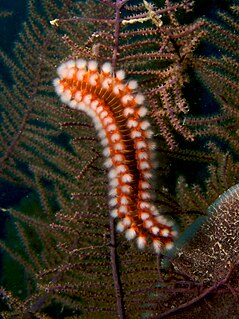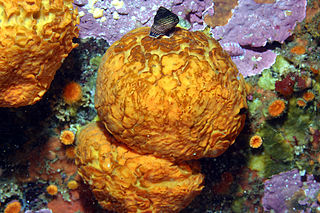 W
WAplysina fistularis, commonly known as the yellow sponge or yellow tube sponge, is a species of sea sponge in the order Verongiida. Aplysina fistularis is a golden or orange-brown color with a conulose surface. The animal is abundant in the Caribbean, where it is commonly found in reefs of open water areas. This sponge was first described by the Prussian zoologist Peter Simon Pallas in 1766.
 W
WThe bearded fireworm is a type of marine bristleworm belonging to the Amphinomidae family, native to the tropical Atlantic Ocean and the Mediterranean Sea.
 W
WBotryllus schlosseri is a colonial ascidian tunicate. It is commonly known as the star tunicate, but it also has several other common names, including star ascidian and golden star tunicate. Colonies grow on slow-moving, submerged objects, plants, and animals in nearshore saltwater environments.
 W
WChloeia flava, also known as the golden fireworm, is a segmented bristleworm belonging to the family Amphinomidae.
 W
WChrysaora hysoscella, the compass jellyfish, is a common species of jellyfish that inhabits coastal waters in temperate regions of the northeastern Atlantic Ocean, including the North Sea and Mediterranean Sea. In the past it was also recorded in the southeastern Atlantic, including South Africa, but this was caused by confusion with close relatives; C. africana, C. fulgida and an undescribed species tentatively referred to as "C. agulhensis".
 W
WEchiurus echiurus is a species of spoon worm in the family Echiuridae. It is found in the North Atlantic Ocean and a subspecies is found in Alaska. It burrows into soft sediment and under boulders and stones in muddy places.
 W
WHalichondria panicea, commonly known as the breadcrumb sponge, is a species of sea sponge belonging to the family Halichondriidae. This is an abundant sponge of coastal areas of the North Atlantic and the Mediterranean Sea ranging from the intertidal zone to a recorded depth of over 550 m. It is also found in the intertidal zone of the coast of the northern part of the North Island of New Zealand. It is very tolerant of a wide range of coastal habitats, including strong currents, high salinity and exposure to powerful wave action. Its only requirement is a rocky substrate which can include small cobbles.
 W
WHydra oligactis, also known as the brown hydra, is a species of hydra found widely dispersed in the northern temperate zone. It is a common organism found in still waters from early Spring to late Autumn.
 W
WHydra viridissima is a species of cnidarian which are commonly found in freshwater, mostly ponds, rivers, and slow flowing parts of streams and rivers in the Northern temperate zone. They are also known as Hydra viridis and Chlorohydra viridissima. Green hydra are typically 10 mm long, and they have tentacles that are about half of their length. They feed on small crustaceans and are strictly carnivorous. Typically they feed on small crustaceans, insects and annelids. Hydra viridissima is often known as the green hydra, the species appears green because of the symbiotic relationship with Chlorella vulgaris, which is a green alga that lives within the organism. Hydra are normally sessile and live on aquatic vegetation. They secrete mucous to attach using their basal disc.
 W
WHydra vulgaris, the fresh-water polyp, is a small animal freshwater hydroid with length from 10mm to 30mm and width about 1 mm.
 W
WLanice conchilega, commonly known as the sand mason worm, is a species of burrowing marine polychaete worm. It builds a characteristic tube which projects from the seabed, consisting of cemented sand grains and shell fragments with a fringe at the top.
 W
WObelia longissima is a colonial species of hydrozoan in the order Leptomedusae. Its hydroid form grows as feathery stems resembling seaweed from a basal stolon. It is found in many temperate and cold seas world-wide but is absent from the tropics.
 W
WSipunculus nudus is a cosmopolitan species of unsegmented marine worm of the phylum Sipuncula, also known as peanut worms.
 W
WSpirobranchus giganteus, commonly known as the Christmas tree worm, is a tube-building polychaete worm belonging to the family Serpulidae.
 W
WTethya aurantium, also known as the golf ball sponge or orange puffball sponge, is a species of sea sponge belonging to the family Tethyidae. It is spherical in shape, with a warty surface, and grows to about 10 cm in diameter. Oscula are present on the upper surface. The surface has sharp protruding spicules which can cause skin irritation if touched.
 W
WThuiaria articulata, the jointed hydroid or sea spleenwort, is a branching colonial hydroid in the family Sertulariidae.